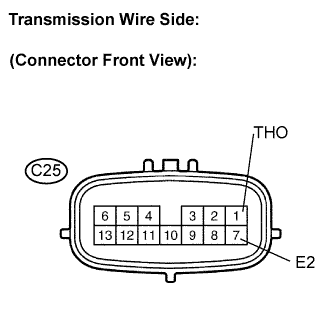DTC P0710 Transmission Fluid Temperature Sensor "A" Circuit |
DTC P0712 Transmission Fluid Temperature Sensor "A" Circuit Low Input |
DTC P0713 Transmission Fluid Temperature Sensor "A" Circuit High Input |
for Preparation Click here
DESCRIPTION
The ATF (Automatic Transmission Fluid) temperature sensor converts the fluid temperature into a resistance value which is input into the ECM.The ECM applies a voltage to the temperature sensor through ECM terminal THO1.
The sensor resistance changes with the transmission fluid temperature. As the temperature becomes higher, the sensor resistance decreases.
One terminal of the sensor is grounded so that the sensor resistance decreases and the voltage goes down as the temperature becomes higher.
The ECM calculates the fluid temperature based on the voltage signal.

| DTC No. | DTC Detection Condition | Trouble Area |
| P0710 | (a) and (b) are detected momentarily within 0.5 sec. when neither P0712 nor P0713 is detected (1-trip detection logic) (a) ATF temperature sensor resistance is less than 79 Ω. (b) ATF temperature sensor resistance is more than 156 kΩ. HINT: Within 0.5 sec., the malfunction switches from (a) to (b) or from (b) to (a) |
|
| P0712 | ATF temperature sensor resistance is less than 79 Ω for 0.5 sec. or more (1-trip detection logic) |
|
| P0713 | ATF temperature sensor resistance is more than 156 kΩ when 15 minutes or more have elapsed after the engine start DTC is detected for 0.5 sec. or more (1-trip detection logic) |
|
MONITOR DESCRIPTION
These DTCs indicate an open or short in the automatic transmission fluid (ATF) temperature sensor (TFT sensor) circuit. The automatic transmission fluid (ATF) temperature sensor converts ATF temperature to an electrical resistance value. Based on the resistance, the ECM determines the ATF temperature, and the ECM detects an opens or shorts in the ATF temperature circuit. If the resistance value of the ATF temperature is less than 79 Ω *1or more than 156 kΩ *2, the ECM interprets this as a fault in the ATF sensor or wiring. The ECM will turn on the MIL and store the DTC.*1: 150°C (302°F) or more is indicated regardless of the actual ATF temperature.
*2: -40°C (-40°F) is indicated regardless of the actual ATF temperature.
- HINT:
- The ATF temperature can be checked on the intelligent tester display.
WIRING DIAGRAM

INSPECTION PROCEDURE
| DATA LIST |
- HINT:
- Using the intelligent tester Data List allows switch, sensor, actuator and other item values to be read without removing any parts. Reading the Data List early in troubleshooting is one way to shorten labor time.
- NOTICE:
- In the table below, the values listed under "Normal Condition" are reference values. Do not depend solely on these reference values when deciding whether a part is faulty or not.
Warm up the engine.
Turn the ignition switch off.
Connect the intelligent tester to the DLC3.
Turn the ignition switch to the ON position.
Turn on the tester.
Select the item "Enter / Powertrain / ECT / Data List".
Follow the instructions on the tester and read the Data List.
Item Measurement Item/
Range (display)Normal Condition A/T Oil Temperature 1 ATF Temp. Sensor Value/
min.: -40°C (-40°F)
max.: 215°C (419°F)Approx. 80°C (176°F) (After Stall Test) - HINT:
- When DTC P0712 is output and intelligent tester output is 150°C (302°F), there is a short circuit.
- When DTC P0713 is output and intelligent tester output is -40°C (-40°F), there is an open circuit.
- Measure the resistance between terminal THO1 (THO) and body ground.
Temperature Displayed Malfunction -40°C (-40°F) Open circuit 150°C (302°F) or more Short circuit - HINT:
- If a circuit related to the ATF temperature sensor become open, P0713 is immediately set (in 0.5 second).
- When P0713 is set, P0711 cannot be detected.
- It is not necessary to inspect the circuit when P0711 is set.
| 1.INSPECT TRANSMISSION WIRE (ATF TEMPERATURE SENSOR) |
Disconnect the transmission wire connector from the transaxle.
 |
Measure the resistance according to the value(s) in the table below.
- Standard resistance:
Tester Connection Specified Condition 1 (THO) - 7 (E2) 79 Ω to 156 kΩ 1 (THO) - Body ground 10 kΩ or higher 7 (E2) - Body ground 10 kΩ or higher
- HINT:
- If the resistance is out of the specified range with either the ATF temperature shown in the table below, the driveability of the vehicle may decrease.
ATF Temperature Specified Condition 20°C (68°F) 3 to 5 kΩ 110°C (230°F) 0.22 to 0.28 kΩ
|
| ||||
| OK | |
| 2.CHECK HARNESS AND CONNECTOR (TRANSMISSION WIRE - ECM) |
Connect the transmission wire connector to the transaxle.
 |
Disconnect the ECM connectors.
Measure the resistance according to the value(s) in the table below.
- Standard resistance:
Tester Connection Specified Condition C24-72 (THO1) - C24-95 (ETHO) 79 Ω to 156 kΩ
Measure the resistance according to the value(s) in the table below.
- Standard resistance (Check for short):
Tester Connection Specified Condition C24-72 (THO1) - Body ground 10 kΩ or higher C24-95 (ETHO) - Body ground
|
| ||||
| OK | ||
| ||
